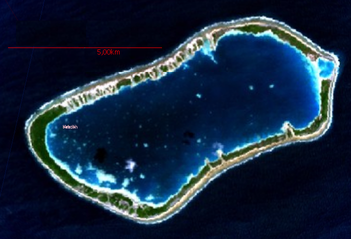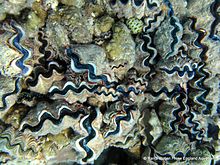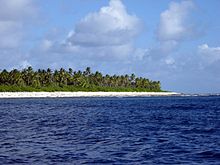- Orona
-
Orona atoll, also known as Hull Island,[1] is one of the Phoenix Islands in the Republic of Kiribati. measures approximately 8.8 km by 4 km, and like Kanton, is a narrow ribbon of land surrounding a sizable lagoon with depths of 15–20 metres. Numerous passages connect the lagoon to the surrounding ocean, only a couple of which will admit even a small boat. Total land area is 3.9 km2, and the maximum elevation is nine metres.[2]
Although occupied at various times during the past, including as late as 2004,[2] Orona is uninhabited today.
Contents
Flora and fauna
Like Manra, Orona is covered with coconut palms (mostly on the western side), towering 12–18 metres above the surface. The remainder of the atoll is covered with scrub forest, herbs and grasses, with a maximum height of 6–12 metres. Feral cats exist on the island, together with rats, pigs and dogs. Ducks and chickens were raised by the former inhabitants, but it is unknown whether any remain. Orona also boasts three species of lizards, Polynesian rats, land and hermit crabs, together with approximately fifty species of insects.[3] Turtles are also known to use the island as a nesting area.
Unlike Manra, whose lagoon is too salty for marine life, Orona's lagoon teems with fish and giant clams.
Two color photos of Orona can be seen at.[4]
History
Like Manra, Orona contains evidence of prehistoric Polynesian inhabitation. An ancient stone marae stands on the eastern tip of the island, together with ruins of shelters, graves and other platforms.[3]
No one is certain who discovered Orona or when, but history shows that it was named "Hull Island" in honor of Commodore Isaac Hull, U.S.N. by Commander Charles Wilkes of the USS Vincennes when he visited the island on 26 August 1840 in the United States Exploring Expedition. It continued to be generally known by this name until the Republic of Kiribati was granted independence in 1979, when its name was changed to the I-Kiribati Orona.
Unlike Manra, Orona does not seem to have been worked for guano, and was apparently not claimed (unlike the other Phoenix Islands) by American guano diggers. The British flag was raised there on 11 July 1889, and the island became part of the Gilbert and Ellice Islands colony. Orona was leased in 1916 to a Captain Allen of the "Samoan Shipping and Trading Company", and became a copra plantation. Allen's lease was bought out by the British government in 1938.
It was one of the islands involved in the Phoenix Islands Settlement Scheme, the final colonial expansion of the British Empire. Residents were evacuated in 1963, due to persistent drought and the declining copra market. Photos of the abandoned settlement, Arariki, circa 1967, may be seen here.[5]
British and American claims to the island ended in 1979 with the independence of Kiribati from Great Britain and the signing of the Treaty of Tarawa by the United States.
The island was briefly reoccupied between 2001 and 2004 by trepangers from the Gilbert Islands supported by a patrol boat of the Kiribati Navy.[6]
Orona, together with the other Phoenix Islands, was proclaimed in 2008 to be part of the Phoenix Islands Protected Area, the world's largest marine protected area.[2]
See also
- List of Guano Island claims
References
- ^ Kiribati Constitution of 12 July 1979
- ^ a b c http://www.phoenixislands.org/orona.html.
- ^ a b http://www.janeresture.com/kiribati_phoenix_group/hull.htm.
- ^ http://www.phoenixislands.org. Look under "The MPA", subheading "The Islands".
- ^ http://www.janesoceania.com/kiribati_hull_images/index.htm
- ^ News from the LinNix in Kiribati
External links
- Oceandots article with satellite photo
- Jane Resture page, with links to 1967 photos
- US-Kiribati Treaty of Friendship
Photo gallery
Kiribati Gilbert Islands 
Phoenix Islands Abariringa · Birnie Island · Enderbury Island · Manra Island · McKean Island · Nikumaroro · Orona · Rawaki IslandLine Islands West of Gilberts Reefs Categories:- Phoenix Islands
- Uninhabited islands of Kiribati
- Atolls of Kiribati
- Islands claimed under the Guano Islands Act
- Former populated places in Oceania
Wikimedia Foundation. 2010.








